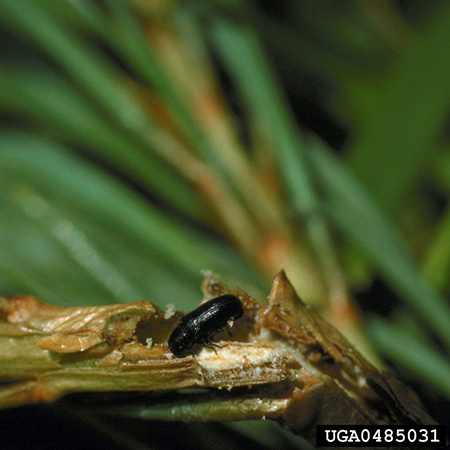Scientific name: Tomicus piniperda Linnaeus
Native range: Europe

At Risk
Scotch (Scots) pine is the primary host for pine shoot beetle although all pines are potential hosts and it is reported to attack other conifers when beetle populations are high. No significant problems have been reported in Minnesota despite the presence of pine shoot beetle for at least ten years.
Distribution
The pine shoot beetle was first found in the U.S. in 1992 (Ohio) and can now be found throughout the Northeast U.S. and Great Lakes Region. It was first found in Minnesota in 2004 when beetles were captured in traps in Anoka, Dakota and Ramsey Counties.
Biology
Pine shoot beetles emerge in early spring. Adult beetles create tunnels beneath the bark of pine logs, stumps or declining trees and reproduce. Eggs are laid underneath the bark where the small larvae feed, complete development and pupate in May and June. These new beetles then emerge from host material and seek out the new shoots of pine trees to tunnel in and feed upon. One beetle may feed in more than one shoot. When temperatures turn cold, beetles will move down to the bottom of the tree and tunnel into the bark to spend the winter. This insect can also introduce various species of blue stain fungi into pines.
Identification
Pine shoot beetles are small insects that are not very distinguishable from other bark beetles to a non-expert. However, it is more likely that the damage from pine shoot beetle will be seen than the insect itself. Damage to pine shoots could be from pine shoot beetle, but a number of moths tunnel in pine shoots as caterpillars including Zimmerman pine moth and European pine shoot moth. Some pathogens also can cause dieback of new shoots such as Diplodia tip blight. Tunneling in pine logs or trees could be from pine shoot beetle or from a number of bark beetles and other insects that infest pine.
Regulatory Status: Not Regulated
In November 2020, USDA deregulated pine shoot beetle. In the past there were restrictions on the movement of materials out of Minnesota that could harbor pine shoot beetle (Christmas trees or other greenery), but those restrictions are no longer in place. However, Christmas trees and other materials are regulated in areas of Minnesota where Lymantria dispar is present.
What Can I Do?
Report potential infestations of pine shoot beetle to the MDA via Arrest the Pest. Currently pine shoot beetle has only been documented to occur in the Twin Cities metropolitan area.

